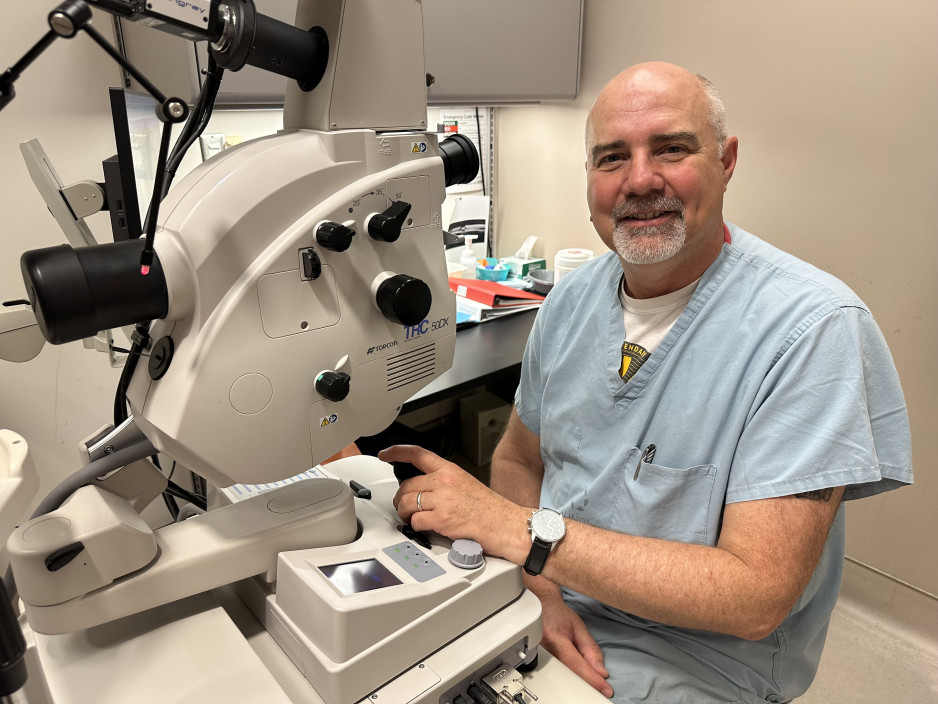From film to focus
On the cusp of graduating from the Advanced Photography Program at Fanshawe College in 1990, Christopher Lincoln was offered an out of the blue proposition. “Who wants to work in a hospital?” a program instructor asked the group of budding photographers. Not knowing exactly what it would mean for someone with his skills and training, Christopher raised his hand.
That decision would be the catalyst for his 34-year-and-counting career in Ophthalmology at St. Joseph’s Health Care London (St. Joseph’s).
As it turns out, St. Joseph’s Ivey Eye Institute was looking for someone who was knowledgeable about film processing including troubleshooting issues using film for eye imaging. A couple interviews later and Christopher found himself ‘working in a hospital’ as an eye imaging technician. “I knew very little about eyes at the time,” he recalls, “so I was sent to Rochester, New York to learn some basic ophthalmic photography techniques and enrolled in the ophthalmic assistant course to learn even more.”
Today, as the largest comprehensive eye care centre in Southwestern Ontario, St. Joseph’s visionary Ivey Eye Institue sees close to 150,00 visits each year. In addition to Opthalmic Technicians like Christopher, the centre is home to Ophthalmologists, Opthalmic Assistants, Orthoptists, Registered Nurses, Residents and administrative professionals who provide specialized care for a wide range of eye condition.
As part of the broader eye care team, Opthalmic Technicians perform various roles including prepping patients to be seen by their specialist, taking medical histories, measuring eye function and administering eye drops. Depending on their specific role, technicians also perform tests to help diagnose or follow the progression of eye disease and even assist in treatment room procedures.
“My role is imaging the eye inside and out,” says Christopher. This includes modalities like retinal angiography - which involves taking pictures of specific parts of the eye, ultrasonography - a procedure that uses sound waves to capture images of the inside and back of the eye, and anterior segment imaging which allows technologists to examine the structure of the eye at various angles for more precise imaging.
The work is fast paced- an element Chistopher enjoys- with a focus on making patients feel comfortable during their testing while simultaneously getting high-quality images for Ophthalmologist to review.
Particularly exciting, says Christopher, are the innovative solutions on the horizon, including new and emerging drugs for age-related macular degeneration, a common eye condition affecting a person’s central vision.
“Technological advances in eye imaging have progressed tremendously,” notes the father of two and stepfather of three. “There are machines that we use as the gold standard for imaging today that weren’t invented when I first started in the department.” At the beginning of his career, there were very few options for treating the disease typically afflicting those over the age of 50. Treatment at the time was focal laser energy used to cauterize leaky blood vessels but in return rendering parts of the retina as non-functioning. Today, injectable drugs are used to treat vessels while preserving the tissue in the retina.
While advancements in technology are exciting, what Christopher values most about his role is his impact on the patient experience. “Everyone has a story when you start talking with them, and sometimes those little chats are enough to make the patient feel a bit more comfortable while being tested,” he says. “At the end of the day, when I go home it's good to know that the work that we do as Ophthalmic Technicians helps our patients.”
Christopher notes that another highlight of his long and successful career is meeting his wife Kathleen, who works as an Ultrasound Technologist at St. Joseph’s, during a chance encounter. The two married in September 2022. “My career as an Ophthalmic Technician at St. Joseph’s has been most rewarding in so many different ways.”
